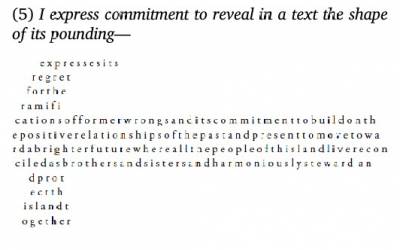This is an old revision of the document!
Table of Contents
Poetry
For the most part, poetry is marked up the same way as other text.
Use Normal style for the content, and Heading styles for chapters, sections, and poem titles.
Poetry is an artistic medium, so we retain direct formatting such as: strong, emphasis, underline, and strikethrough.
Languages can be applied as needed. See the Language section for more info.
Complex Formatting and Producer's Notes
Sometimes you will come across a poem that has more complex formatting that cannot be translated to EPUB.
We cannot retain this formatting for EPUB conversion.
Producer's Note
In these cases where we have removed complex formatting include a Producer's Note section at the beginning of the book.
Producer's Note [Heading Style 1]
This book originally appeared with special paragraph and line spaces that added to the meaning of the text. Due to the conversion process these design elements have been removed.
For more info, see the Producer's Note page.
Common Types of Complex Formatting
The more common forms of complex formatting are:
- spacing,
- line justification,
- and concrete poetry.
In poetry the use of blank space on a page, between lines, words, or even letters, can be used to convey meaning. We do not retain blank spaces.
Lines, stanzas, or entire poems can use right justification to convey meaning. We do not retain right justification.
A concrete poem is a poem where the words create a shape on the page that conveys a visual meaning. We do not retain the original shape of a concrete poem.
Example Original Poem:
Example Transcribed Poem:
expresses its
regret
for the
ramifications of former wrongs and its commitment to
build on the positive relationships of the past and
present to move toward a brighter future where all the
people of this land live reconciled as brothers and
sisters and harmoniously steward and protect
the
island together
Images in Poems
Sometimes you will come across images of text in poems. This is a big no-no in publishing and not accessible. See the section on Images of Text for more info.
We transcribe all images of text and mark up with the appropriate NNELS styles.
Sometimes you will find the poet has used an image of a black bar to signify the censorship of a word of phase. In this can you can keep the image and add the alt-text "Thick black bar blocking out word/phrase."
Q&A Archive
Q: I'm wondering about alignment and spacing. The poet in the book I'm editing (Silvija) makes use of left and right justification at some points in the book. Should I align the text as the poet did or stick to right justification only? Also, the book contains a lot of white space (poems are on separate pages). Should I add page breaks in this case? Finally, I just want to verify that the slash ('/') that is used in poetry should remain as written or changed somehow for conversion into DAISY? Thanks!
A: Poetry is a controversial area of ebook production :) NNELS takes the approach of using left justification for all our documents. For some people, text justification may present readability issues. Extended spaces between words and sometimes letters within words can create spaces of white that can visually dominate the text. If you use screen magnification then magnifying these spaces of white, in particular the space in between words, can increase the need for scrolling beyond what would be required if text was aligned to one side.
You can delete all empty pages as we don't have to worry about retaining the original page numbers in this work. We can still put each poem on a separate page.
And yes, do use all the original punctuation. TTS is good at reading punctuation. If you're curious how TTS can read text, you can enable the built-in dictation software on your iOS (VoiceOver) or Windows. Keep in mind that TTS software tend to differ Screenreaders.

